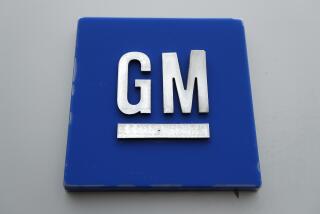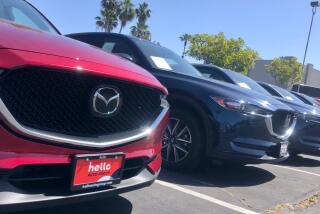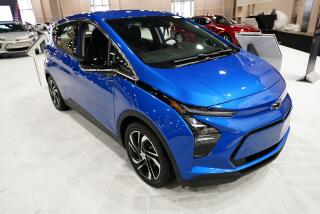Mid-Size Import-Brand Sedans Top Crash Test
- Share via
DETROIT — Among mid-size sedans, import brands dominated the crash-worthiness ratings released Tuesday by an insurance safety group that conducts independent tests.
All 13 of the Insurance Institute for Highway Safety’s crash-worthy “best picks” for inexpensive, moderately priced and luxury mid-size sedans were import models, seven of them Japanese.
Toyota had the most best picks--five--with the 1997-2001 Camry as well as the redesigned 2002 Camry, the 2000-2002 Avalon, the 2002 Lexus ES 300 and the 2002 Lexus IS 300. The other best picks came from Acura, BMW, Mercedes-Benz, Saab, Subaru, Volkswagen and Volvo.
Only two American models received “good” rankings: the 2001-2002 Chrysler Sebring/Dodge Stratus and the 1997-2001 Cadillac Catera, which has been discontinued.
“Clearly, imports have done well,” IIHS Senior Vice President Steven Oesch said.
Of the 49 mid-size models tested, 21 were “good” and 17 were deemed “acceptable.” Two were “marginal” and nine were rated “poor.” The cars include all major mid-size models in the U.S. market, although some models such as the Ford Contour and Plymouth Breeze have been discontinued.
The IIHS conducts frontal offset crash tests at 40 miles per hour, simulating an impact in which the corners of two cars approaching each other collide. Federal government tests, conducted by the National Highway Traffic Safety Administration, are head-on collisions with a barrier at 35 miles per hour.
“It doesn’t surprise me that the importers dominated, because they always have been more focused on engineering,” said auto safety advocate Clarence Ditlow, director of the National Center for Auto Safety in Washington. “When the National Highway Traffic Safety Administration began its frontal crash testing in 1980, every Japanese car failed, and two out of three American cars passed,” Ditlow said. “Then every new Japanese model after 1980 passed the tests.”
Ditlow favors all crash testing because it exposes weaknesses in vehicle structure, but he said he prefers NHTSA’s full-frontal crash test to the Insurance Institute’s offset crash. “The IIHS measures intrusion into the lower occupant area rather than high-speed survivability,” while NHTSA tests protection of the head and chest area, he said. “We urge consumers to look at vehicles that do well on both tests.”
Passenger cars have become significantly safer in the seven years the institute has been conducting tests, IIHS President Brian O’Neill said. “This set of results demonstrates the effectiveness of consumer safety information in improving crash-worthiness,” O’Neill said.
When the institute began testing cars in 1995 only three of 14 were rated good, he said. “Now it’s unusual for us to test a new vehicle design in any size class and not get a good performance,” he said.
Although auto makers do not consult with the IIHS in engineering their cars to do well in the offset crash tests, “We certainly believe that our tests have been a major influence in encouraging manufacturers to make improvements in their vehicles,” Oesch said. “We know that consumers use this information in their buying decisions.”
General Motors Corp., the world’s largest auto maker, and Toyota Motor Sales USA, the largest importer in this country, said the IIHS tests were important, but that they do not establish safety standards based on whether their cars can pass the institute’s tests.
“We run a battery of tests; this is just one component,” said GM spokesman Jay Cooney. “We don’t design our vehicles to pass that one test.
“Should you go to the bank on this one test? No. Should it be one of the factors considered when purchasing a car? Of course.”
Toyota spokesman Joe Tetherow said the Japanese auto maker was pleased with its performance, but also conducts numerous tests to ensure safety. “Probably some consideration is given [to the IIHS tests], but overall safety is the key component,” Tetherow said.
Auto makers don’t hesitate to use positive IIHS results in their marketing. Certain ads for the Mercedes M-class sport utility vehicle, BMW 3- and 5-series sedans and X5 SUV, Pontiac Bonneville, Ford Focus, Buick LeSabre and Ford Taurus note their “good” IIHS rating. (The IIHS classifies the Taurus as a large family car rather than a mid-size sedan.)
Toyota had a TV ad campaign for its 2000 Sienna minivan built around its top IIHS rating, showing the van in a crash test with a Tina Turner song, “Simply the Best,” playing in the background.
Best Picks
These mid-size sedans were rated best for crash-worthiness:
Make/model Year
Acura TL 1999-2002
BMW 3-series 2000-2002
Lexus ES 300 2002
Lexus IS 300 2002
Mercedes C Class* 2001-2002
Saab 9-5 2002
Subaru Legacy 2000-2002
Toyota Avalon 2000-2002
Toyota Camry 1997-2001
Toyota Camry 2002
Volkswagen Passat 1998-2002
Volvo 850/S70 1993-2000
Volvo S80 2001-2002
*Highest ranking for this category
Source: IIHS






